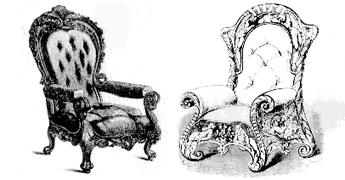
When many people think of the term Victorian, they envisage this kind of extremely ornate, even cluttered furniture proudly shown at the 1851 Crystal Palace exhibition. During the decades of the twentieth century when the stripped-down, supposedly functional aesthetic of High Modernism ruled, most found it difficult to take seriously any Victorian furniture and design anything other than the proto-modern work inspired by Ruskin and Morris.
Look at the way the designers of this hideous furniture treat surface, overall design, and allusion and see how many similarities you can discern between this still unfashionable work and the writings of, say, Carlyle, Dickens, Elizabeth and Robert Browning, and Trollope. To begin with, what are the literary analogues of surface embellishment in this furniture?
Follow for more examples of this kind of design — and the reactions against it.
Not everyone agrees with the above. Some 19 years after I put this above material online, I received the following, which I assume is not a spoof, though the author may not have seen the hundreds of examples of beautiful Victorian furniture I include in The Victorian Web:
Dear Mr. Landow,
I am appalled by your words of Victorian Furniture. I came across your site (http://www.victorianweb.org/art/design/clutter1.html) and was horrified by your comment of the Victorian designed furniture. You said it was hideous and unfashionable work. I say my good man, it is exquisite design and work, a true beauty. I would like you to know that I take a quite liking in Victorian Era. Unlike today, back then there were Gentlemen and Ladies. They acted and dressed like it and their homes and furniture reflected it a great deal. Please do not misinterpret this e-mail, I'm just merrily voicing what I feel. Thank you for taking time to read this and I wish you a good day, Sir.
Sincerely,
M. P. Bolen [mpbolen2006@yahoo.com]
Created 1988; Last modified 17 May 2007